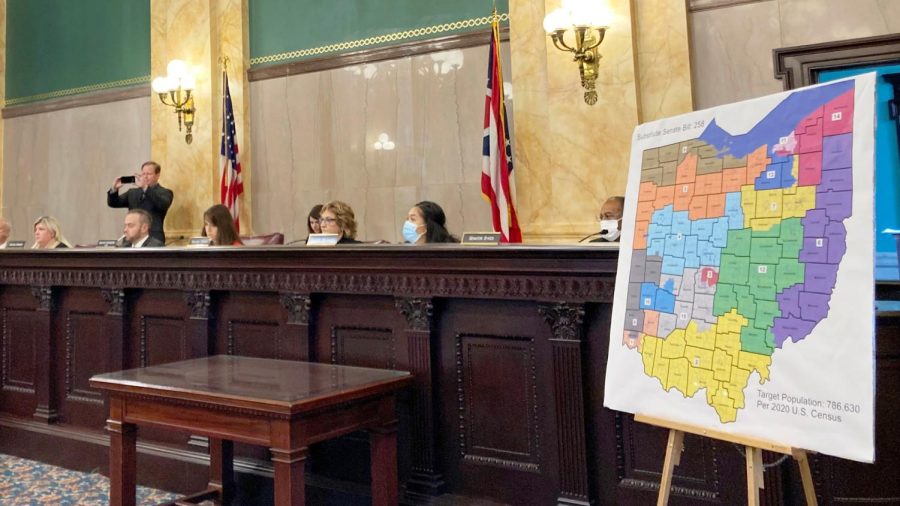The current state of gerrymandering
January 21, 2022
Congressional redistricting is both fascinating and highly influential. After each census, states are obligated to rearrange the distribution of their congressional districts to ensure that the population in each of the districts is the same or closely similar. However, this process of redistricting is often driven by political gain through a phenomenon called gerrymandering. By gerrymandering congressional maps, the party in power of the state-redistricting process draws the districts in a way that benefits their particular political party. Here is an update of, so far, the most preposterous cases of gerrymandering seen in this current redistricting cycle:
Illinois (Gerrymandered by Democrats)
The Illinois Democratic Party holds a reputation of being perhaps the most ruthless group of Democrats in the country. After Illinois lost a congressional district due to population loss, its Democrats held complete control over the 17 current congressional districts of the state. Currently, Democrats hold 13 of Illinois districts, while Republicans hold 5 of the districts. However, with the already-approved map, Democrats are expected to control 14 of the congressional districts, while Republicans are expected to hold 3, making it a net-gain of 2 districts for Democrats. Republican Rep. Rodney Davis, who is expected to be a victim of this unfair redistricting, called the process “a shameful, partisan gerrymander in a desperate attempt to keep Nancy Pelosi in power.”
North Carolina (Gerrymandered by Republicans)
North Carolina is a true 50-50 state. In the 2020 election, it voted for Trump by about 1.5% and at the same time, re-elected its Democratic Gov. Roy Cooper by 4.5%. However, the Republican-controlled North Carolina legislature passed a congressional map that does not distribute its 14 congressional districts in a way that reflects the battleground nature of the state. In the new congressional map, Republicans are expected to control 10 of the districts, Democrats are expected to control 3, and one of the districts is expected to be a “toss-up,” meaning any party could win it.
The map, however, is already facing legal challenges as some claim it dilutes the power of minority constituencies. As these lawsuits continue, politicians expect that they will eventually reach the State Supreme Court, which will decide whether these maps are legal. Due to the fact that the State Supreme Court is majority Democrat, there is a potential chance that North Carolina’s congressional map could be overturned and a fairer map drawn.
Oregon (Gerrymandered by Democrats)
Although both Illinois and North Carolina are states with large populations, the new Oregon congressional map shows gerrymandering is not solely present in big states. Due to large population growth, Oregon received another congressional district, allowing Oregon Democrats to draw a map rooted in Democratic success. In the new map, Democrats are expected to control 4 or 5 seats, while Republicans are expected to control 1, and if they are lucky, 2 at most. This gerrymander is particularly messy as Oregon Democrats had to connect large rural sections to the hyper-liberal city of Portland in order to include them into Democrat-leaning districts. In a state where Republicans received 42% of the vote in 2020, they are expected to control 16% to 33% of congressional districts.
Honorable Mention: Ohio (Gerrymandered by Republicans)
Ohio Republicans committed perhaps the most avoidable mistake in the current redistricting cycle. In 2015, Ohio voters passed a resolution that established a bipartisan redistricting commission. Thus, hypothetically, the Ohio redistricting process should be fair. Nevertheless, hopes for a fair map were dashed as the Ohio Redistricting Commission was unable to agree on a map by the designated deadline, and the Republican-controlled legislature was given complete responsibility of drawing the map. In the map that they drew, Republicans were likely granted 12 districts and Democrats granted 3 districts. This composition clearly does not reflect the actual political affiliation of Ohio, a state where Democrats received 42% of the vote in 2020.
In a surprising twist of events, the Republican-controlled Ohio Supreme Court overturned the congressional map, claiming that it did not properly commit to the partisan-fairness requirement in the Ohio state constitution. Thus, with new maps having to be drawn, it is likely that Democrats will find themselves in a better position than the one they were in before the redistricting process. Ironically, Democrats benefited from gerrymandering perpetuated by Republicans.


